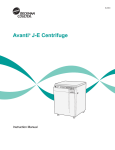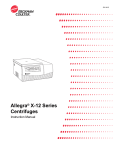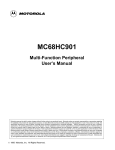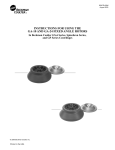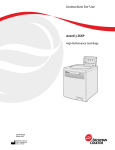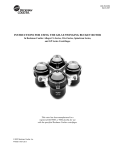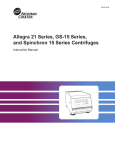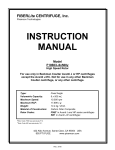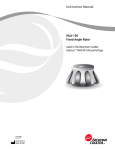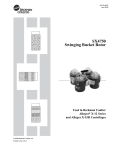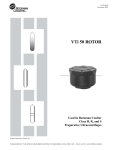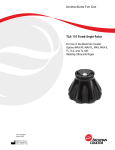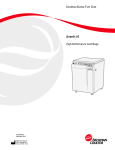Download Get Your Rotor Safety Guide Here (DS-18540)
Transcript
Rotor Safety Guide Introduction Most of us appreciate the need for careful design, handling, and maintenance of certain kinds of laboratory equipment—the optics of a spectrophotometer, for instance. It may not be obvious, however, that anything as substantial-looking as a centrifuge rotor must be designed to exacting specifications, and properly maintained during use in order for it to fulfill its life expectancy. If you consider that during rotation, an ultracentrifuge rotor may experience 1,000,000 times the force of gravity, it becomes apparent that seemingly minor flaws will assume much greater significance at these g-forces. In effect, one gram will “weigh” 1,000 kilograms, and a tiny flaw in a critical part may generate stresses greater than the rotor was designed to withstand. The three factors that govern a safe life for any rotor are: • Exper t design and manufacture • Proper care and handling during use • Retirement, when damage or fatigue make continued use unsafe We hope this rotor safety guide will clarify these points. Because after you purchase a rotor, its safety largely depends on you—the person responsible for its use, maintenance, and retirement. Design of a Rotor Beckman Coulter designs rotors to meet the diverse needs of the Research, Medical, Industrial and Bioprocessing communities. We rely on direct customer feedback to determine where gaps in the rotor portfolio may exist. Once identified, we formulate rotor design objectives to develop new products to fulfill customer needs. Our engineers create solid modeling concepts and utilize finite element analysis (FEA) to simulate the rotor stresses that will occur in the day-to-day usage. We then conduct dynamic characterization of the rotor, drive and centrifuge to ensure total system stability. Based upon the rotor’s intended usage profile, years of cumulative engineering experience are applied to select the ideal materials and geometry to optimize the size, weight and required strength of the rotor. When appropriate, composite materials may be designated. DS-18540A figure 1. Computer-Generated Model for Finite Element Analysis of a Fixed-Angle Rotor. The next step is fabricating prototype rotors and subjecting them to an extensive testing regimen. Beckman Coulter engineers verify the rotor design life by repeatedly cycling up to its maximum speed. Single-cycle burst tests prove the robustness of the design and verify fragment containment. Finally, Beckman Coulter application scientists conduct laboratory protocols to verify that the rotor will achieve the desired particle separations. Only after meeting all design criteria is the rotor released to manufacturing for production. Stringent inspection of each rotor is observed from the forging stage to the finished product. The rotors are precisely balanced and stability is confirmed before undergoing a “high-stress test” that ensures the rotor will have a long, safe life in your laboratory. Our confidence in these design and test procedures enables us to warrant our rotors and centrifuges against defects in materials and workmanship. However, each warranty is based on the concept of a Beckman Coulter designed and tested rotor/centrifuge system in which the characteristics of the rotor, drive, instrument and containment have been carefully matched to ensure safe operation. Beckman Coulter does not warrant its rotors when operating in other centrifuges and does not warrant its centrifuges when used with other manufacturers’ rotors. Why Rotors Fail The most careful design may not protect a rotor against misuse or abuse when it is in service. The centrifuge user should understand the causes of rotor failure in order to prevent them from happening. Stress The centrifugal force created by high rotational speeds generates the load or stress on the metal of the rotor, which causes it to stretch and change in size. Figure 2 is a plot of stress against this dimensional change (strain) for a typical rotor alloy. The first section of the curve is the elastic region, where the alloy will return to its original dimensions after the load is removed. At a certain level of stress, however, the elastic limit of the alloy will be exceeded—the rotor will not regain its original size and shape at the end of the run. Plastic damage has occurred which may initiate a failure of the rotor at some point. The maximum speed and sample density ratings designated by Beckman Coulter for each rotor are intended to prevent this type of damage and should always be observed. stress cycles it experiences, these small changes will eventually become microscopic cracks. With continued use, the cracks will enlarge, and failure of the rotor will ultimately occur. You may have noticed that Beckman Coulter provides a different type of warranty for its Ultracentrifuge rotors than it does for its lower speed rotors. Metal fatigue is one consideration in determining these warranty provisions. To meet demanding operating requirements, many Ultracentrifuge rotors are designed close to the elastic limits of their alloys. Because these rotors may fail due to metal fatigue if used for more than a certain number of runs or hours, the useful rotor lifetime is based on a lower number of years of usage than the HighPerformance or Benchtop Series rotors. Rotors for lower-speed centrifuges, such as the Beckman Coulter High-Performance and Benchtop instruments, however, are designed to operate far below the elastic limits of their alloys. Consequently, the useful lifetime on these rotors is a longer time period. See the table on the next page for an overview on the warranty period and retirement recommendations for each class of rotor. STRESS CORROSION Corrosion—the attack on metal surfaces by moisture, chemicals, or alkaline solutions such as cesium chloride or other salts—is an aluminum rotor’s worst enemy (see Figure 3). The resultant pitting reduces the amount of metal available to bear stress during operation at speed. When this occurs in a highly stressed area, such as the bottom of a cell hole in a fixed-angle rotor, the increased load on the remaining metal results in a so-called stress concentrator. Repeated use will cause cracks to develop, and failure of the rotor will result. This combination of stress and corrosion is called stress corrosion. It will cause failure sooner and at a much lower level of stress than if the rotor were undamaged by corrosion. Stress corrosion is the primary cause of failure of aluminum rotors, especially as they age. Suggestions for avoiding it are discussed in the next section. Figure 2. Stress/Strain Plot of a Typical Rotor Alloy. Metal Fatigue Any metal structure, following a certain number of stress cycles, will eventually suffer fatigue. When a rotor is repeatedly run up to operating speed and then decelerated, the cyclic stretching and relaxing of the metal cause changes in its microstructure. Depending on how close the rotor is operated to the elastic limit of the metal, and how many alternating Figure 3. Corroded Aluminum Rotor. Warranty and Retirement Recommendations Warranty Years* Retire After Years Swinging Bucket Ultracentrifuge Rotors 5 10 2,400 Titanium Fixed Angle, VTi & NVT 5 12 6,000 5 12 3,200 Aluminum Fixed Angle 5 10 2,400 TL & ML Series 5 12 N/A VTi 65.2 Retire After Runs MLA-130 Lid 5 12 2,000 MLA-150 5 12 1,500 Airfuge Rotors 1 10 N/A 5 yrs. or 2,000 runs 10 2,000 5 12 6,000 Avanti J Series 7 15 50,000 J6 Series 7 15 50,000 JLA-10.500, 8.1000 & 9.1000 Cannisters 7 7 N/A Carbon Fiber F10BCI & F14BCI 7 7 N/A Zonal & Continuous Flow Analytical, Titanium High-Performance Rotors Benchtop Rotors Allegra Series 7 10 N/A SX4750/A Bucket 7 10 32,000 Spinchron DLX 7 10 N/A Microfuge Series, Aluminum 7 10 N/A Microfuge Series, Plastic 1 5 N/A *This warranty is valid for the time periods indicated from the date of shipment to the original buyer by Beckman Coulter or an authorized Beckman Coulter representative. Proper Use and Maintenance All rotors are designed to carry a maximum load at a specific maximum speed. Since even one run made under conditions of excessive stress may significantly reduce the fatigue life of a rotor, it is important to abide by the operational specifications published in each rotor manual. Speed reductions required for running high-density precipitated solutions, plastic adapters, half-filled uncapped thick-wall plastic tubes in fixed-angle rotors, or stainless steel tubes should always be observed. Swinging bucket rotors must be run with all buckets present, and sample loads should be balanced. For the rotors that utilize carbonfiber composite cannisters, all cannisters must be used at all times, even if there is no bottle inside the cannister. Each Beckman Coulter Ultracentrifuge rotor carries an overspeed disk that prevents it from exceeding its maximumrated speed through operator error or instrument malfunction. But it is the user’s responsibility to be sure that the correct disk is on the bottom of the rotor, that the disk is in good condition, and that a speed-derating disk is installed, if and when the warranty conditions requires it. With the exception of Zonal and Continuous Flow Ultracentrifuge rotors, rotor logging is not mandatory per warranty but may be desirable for good laboratory practices. Rotors for the Beckman Coulter J6 centrifuges are protected from dangerous single-cycle overspeed condition by windage or by the power limitations of the drive. The Avanti J Series centrifuges have a rotor identification system, which uses windage/rotor inertia measurements or special magnets to automatically limit the maximum speed setting of the instrument. The centrifuge user should take care to prevent overspeeding by setting the proper run speed each time, because the fatigue life of the rotor will be reduced by this. The purchase date of each rotor should be recorded and kept on permanent file. Note that the purchase date may be somewhat different from the manufacturing date shown in the rotor serial number. There is an expiration date permanently marked on some rotors and rotor accessories. The component must not be used beyond its expiration date under any circumstances. Most rotors are fabricated from titanium or aluminum alloys—materials that have high strength-to-weight ratios. Titanium has another desirable characteristic: it is quite resistant to corrosion. Aluminum is less expensive, but far more susceptible to corrosion. If a rotor will be frequently used with corrosive salt solutions, such as cesium chloride or potassium bromide, a titanium rotor may be a better choice. Note that even if the rotor is made from a titanium alloy, other components, including lids, knobs, spacers, caps, and plugs may be made from aluminum alloys because of design considerations. These components are also susceptible to corrosion and should be cared for following the recommendations for aluminum rotors (see below). a rotor, check the classification of your instrument to be sure it matches that of the rotor selected. This classification is stamped on the lid or top of all Beckman Coulter FloorModel Ultracentrifuge rotors. All Beckman Coulter aluminum rotors are anodized with a thin coat of aluminum oxide that protects the underlying metal as long as this oxide layer remains unbroken. If it is scratched or otherwise damaged, however, corrosion will occur. Thus some precautions must be taken when cleaning these rotors after use. This program has two purposes: (1) to prevent premature failures by detection of stress corrosion, metal fatigue, wear or damage to anodized coatings; and (2) to instruct laboratory personnel in the proper care of rotors. The FRIP program is available to all owners of Beckman Coulter Ultra and High-Performance Centrifuges. Contact your local Beckman Coulter Field Service Office for arrangements. First, rotor cavities and buckets must never be cleaned with an ordinary bottle brush with sharp wire ends. Any contact with these or other sharp instruments could easily damage the anodized layer, creating a site for stress corrosion to begin. Special plastic-coated brushes available from Beckman Coulter should be used. Alkaline detergents or cleaning solutions, which may remove the anodized coating, must be avoided. (Most commercially available solutions designed for radioactive decontamination are highly alkaline.) A mild detergent* such as Beckman 555, will not attack the anodized surface. If corrosive materials have been run or spilled on the rotor, wash it immediately. Particular care should be taken when aluminum swinging bucket rotors or aluminum fixed-angle rotors have been used with uncapped tubes containing cesium chloride or other salts. Any salt crystals will corrode the metal unless carefully washed away. Only the buckets of a swinging bucket rotor should be washed. The body of the rotor should never be immersed; the hanger mechanisms are hard to dry and can rust. After the rotor has been cleaned and thoroughly rinsed with water, it should be air-dried with buckets or cavities upside down. All fixed-angle vertical tube and near-vertical tube rotors should be stored upside down, with the lids or plugs removed. Swinging bucket rotors should be stored with bucket caps removed. Store all rotors in a dry environment, not in the centrifuge. Any moisture or other contamination present during storage is a potential source of corrosion. There are manuals* covering rotors and tubes for Preparative Ultracentrifuges, Tabletop Ultracentrifuges, and HighPerformance Centrifuges that every user should read, as well as the instruction manual that accompanies each rotor. These publications cover operation, cleaning, lubrication, and storage in more detail. Ultracentrifuge Classification Program All Beckman Coulter Floor-Model Ultracentrifuges are classified according to the rotors that can be safely used in them. Rotor/ultracentrifuge compatibility is a function of the rotor chamber size, the type of overspeed protection, the kind of chamber door and barrier ring. Before running Field Rotor Inspection Program (FRIP) At your request, a specially trained Beckman Coulter representative will come to your lab and examine all your rotors. Using nondestructive methods (fiber-optics borescopy), they may find signs of corrosion or other damage. If so, they will recommend repair or replacement, and a potentially costly failure may be prevented. A formal presentation is also given to provide information about maintenance procedures and rotor damage and its significance. The stress corrosion of aluminum rotors, in particular, can be greatly reduced by good laboratory practice. Sometimes rotor corrosion is so bad it is easily visible to the naked eye (see Figure 3). At other times, it is less apparent. If you have doubt about the condition of a single Beckman Coulter rotor, you may return it to the factory in Indianapolis, Indiana, where it will be inspected free of charge. Before shipping the rotor, you must contact the nearest Beckman Coulter office for specific instructions. A written statement must accompany each rotor, indicating that it is safe to handle (free of any pathogenic or radioactive contamination). Out-of-Warranty Rotors and Rotor Retirement Every rotor, no matter how well-designed or well cared for, will someday reach the point where it may fail during operation. Metal fatigue, invisible to the naked eye, will have taken its toll with every use. When the warranty period has expired, consideration should be given to the retirement of the rotor. Beckman Coulter Ultracentrifuges are designed to contain the physical destruction that results from the mechanical failure of a Beckman Coulter rotor. However, the risk of losing valuable samples and severely damaging the instruments make the use of out-of-warranty rotors a costly gamble. Rotors used in Beckman Coulter High-Performance Centrifuges have been designed and tested to ensure a normal fatigue life that extends beyond the number of cycles that could ever be run during the 7-year warranty cycle. However, after many years of use, there will inevitably be some corrosion or stress corrosion. At some point, the combination of such damage and metal fatigue could make the rotor vulnerable to a failure. Although a rotor may appear to be in good condition, once the warranty period has been reached you should consider retiring the rotor. In all cases, we urge you to follow the rotor retirement recommendations shown earlier in this document. Some rotor components have a warranty period that is the same as their expiration date. Because these components are highly stressed, there is a strong possibility that the component could fail with prolonged use. It is essential that the component be taken out of service and retired once the expiration date has been reached. Some of the components that have expiration dates include carbon-fiber cannisters, carriers and some labware. The expiration date or manufacturing date is usually engraved or molded into the component. Refer to the individual rotor manuals for specific information on the expiration dates. list of suitable detergents is given in the “Appendix A: Chemical Resistances” in the A following publications. This information is also available in Chemical Resistances, IN-175. This list of common laboratory chemicals and their effect on rotor and tube materials should always be consulted if the possible interaction is in doubt. Rotors and Tubes for Preparative Ultracentrifuges, publication LR-IM-24 Rotors and Tubes for Tabletop Preparative Ultracentrifuges, publication TLR-IM-9 Rotors and Tubes for J2, J6, and Avanti J Series Centrifuges, publication JR-IM-10 * Beckman Coulter, Avanti, Allegra, Airfuge, Microfuge, and the stylized logo are trademarks of Beckman Coulter, Inc. and are registered with the USPTO. Spinchron is a trademark of Beckman Coulter, Inc. For Beckman Coulter’s worldwide office locations and phone numbers, please visit “Contact Us” at www.beckmancoulter.com BR2013-14517 © 2013 Beckman Coulter, Inc. PRINTED IN U.S.A.





